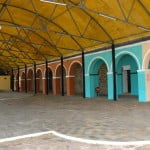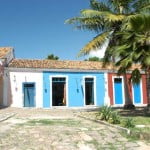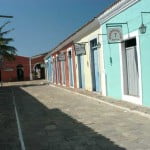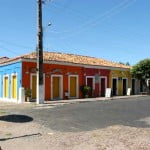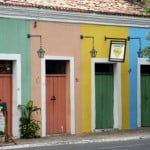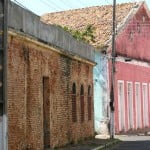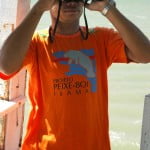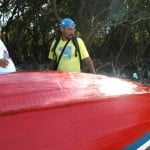Monday, August 1st , 2005
We traveled all day long. We left São Paulo for Brasilia, where we had to wait for two hours for our connection. Afterwards we went to Teresina and landed at 2 p.m. Then we took a taxi that drove us 400 kilometers to Luis Correia, where we arrived early in the evening. We were tired because of the trip, of Piaui”s hot weather and of Antonio”s endless conversations, our driver, who spoke compulsively. He talked comfortably about different subjects. However, the main one was corruption, of course. Antonio mentioned not only dollars in underpants worn by PT politicians, he also complained about Piaui”s bad road state, badly signaled, plenty of holes, and no roadsides. He is another disillusioned Brazilian who knows that the money is sent from Brasilia to repair the road but the total sum rarely reaches the right destination. A toll here, a commission there, a bite over there, and the result is what depends on public money is very often in a miserable state, since when the money arrives, more than half of the sum has been “eaten” on the way, there is just small change left for public works…
His endless talk made me confused. When the trip was about to finish and he started to talk restlessly, I laid my head on the back of the seat and pretended to sleep in order not to answer. During one of his comments I almost choked when I heard him say his wife suffers terribly from stomach aches. She has already been to several doctors, but nobody knows the cause of the pain. He has his own theory and thinks she is very stressed and works too much. When they were on vacation she ate everything she wanted and didn”t feel sick. “You know, Mr. João, after she eats, if she romits, or works, she suffers just a little.” Yes, here in Piaui, people use “r” instead of “v” at the beginning of the word. As far as “to work” is concerned, I believe the translation is unnecessary. But when I heard this expression, I was stunned and was ready for the worst. Fortunately, Mr. Antonio stopped there and didn”t give any additional explanation…
Tuesday, August 2nd, 2005.
Today we made footage in Parnaiba which is some miles away from Luis Correia and is a charming city born alongside the Paranaiba river. In the old part of the city, the area of Porto da Barca, there is a beautiful block of buildings from the 18th and 19th centuries, when Parnaiba was an important port to flow the cattle production straight to Europe. There are just a few buildings and mansions, but the ones that are left were renewed and today they are in good shape. Some have glazed tiles on the façade, such as those from São Luis, in Maranhão. As we shot, we made appointments for the following days, and found out about the coastal problems in this part of the country. And they are not very few. This is an area with mangroves, dunes, sand bars, lagoons, etc., besides the fact of being the mouth of important rivers in north-eastern Brazil: Parnaiba, with its huge Delta, Timonha and Ubatuba. It is a fragile area where the economy is still incipient, and the main economic activities are non-industrial fishing – fish, shrimp and especially lobster – and the fishing fleet has approximately 280 boats. There are also salt mines, some cattle breeding, extraction, and more recently the notorious crustacean culture. In the past, the Carnauba”s wax industry was the leading economic activity. But today, with low prices, it operates within 10% of the capacity. We had also planned to go to the mouth of Ubatuba and Timonha rivers, 20 miles to the south, in order to visit one of the bases of Peixe Boi Project, in the district of Cajueiro da Praia.
After filming, when it was getting dark, we took a taxi and went there, where the person in charge of the base, Magnus Severo Machado, was waiting for us. We decided to go and watch the Peixes Boi, early in the following morning, so we just introduced ourselves and went to a small hotel in the town where we slept.
Wednesday, August 3rd, 2005.
We woke up at 5 a.m. We had a fast breakfast and left with Magnus, the person in charge of the base. He took us on his motorcycle to the beach where we got on a sail canoe like the bianas from Maranhão, but here cock tail sails are used like those used in jangadas (rafts). It was great. I always wanted to sail in a boat like this and today my dream came true. He took us to the middle of the bay where the rivers Ubatuba and Timonha flow. There, right in the middle of the mouth of these rivers, there is a wood tower. That”s where they usually wait to monitor the peixes boi. By the way, Cajueiro was the only place in Brazil where it was possible to shoot the birth of one of these mammals. Magnus told us that according to the last census taken in the 90”s, about 15 individuals of this species were counted. Since each female can have up to one young per year, the total population can be bigger, although nobody knows the right amount.
The peixe-boi is a huge and docile mammal that is fed basically by grass and aquatic herbs. It has been systematically hunted, consequently on the edge of extinction. The predatory hunting dates from a period of time during which there were only natives on the Brazilian coast who hunted them because of the amount of meat that it was possible to get from it. Later, when Europeans arrived and colonization started, the slaughtering accelerated. For some years, Manaus and Belem streets were illuminated by lanterns in which the oil from peixe-boi was used. Later, the inhabitants living on river banks continued to hunt them especially for the meat but also for the hard and resistant skin that was used to manufacture belts and the bones were also used to manufacture tool handles. The docile nature of the peixe-boi that comes frequently to the surface to breath also helps to increase this devastation. When they were on the surface of the water, caboclos used to stick pieces of wood into their nostrils to kill them by asphyxiation. Thus, there are just a few of them spread in the Amazon, those that live in fresh water, and the marine ones on the coast between Maranhão and Alagoas.
On the top of the tower we heard all morning long good stories told by Magnus and two inhabitants from Cajueiro da Praia who were with us. Unfortunately, we were not lucky, we couldn”t see any peixe-boi.
From the top of the tower we could see some farms of crustacean culture in neighboring mangroves, especially in the mouth of Ubatuba river. The devastation caused is unbelievable. To start with, all the vegetation is removed in order to build fattening tanks. In addition to the destruction of this natural nursery of marine life, a toxic substance, metabisulfite, an antioxidant is shed in order to keep the color of the shrimps after they die. When this process is over, this substance is thrown back to the water of the estuary without being treated. And what is worse is the fact that mangroves are public areas that are conceded with the connivance of the authorities, since it is Ibama (Brazilian Environment and Natural Resources Institute) in Piaui that gives permits to the areas of crustacean culture. In other states, the permit can be given by their own institutes, such as departments in charge of the environment.
There is a lot more to say about the short and beautiful coast of Piaui (just 66 kilometers). Just these comments for the time being. We will continue tomorrow.
Thursday, August 4th, 2005.
In the district of Cajueiro da Praia there are about six thousand inhabitants living alongside four beaches and in the country. The main village is nice, extremely clean, the streets are paved with stones, the houses are made of brick, simple and cozy. They are generally one-story houses built after the end of the beach behind a line of coconut trees, the roofs are not higher than the crown of the trees. Consequently, from the sea one can barely see the village and all the beaches, although they are occupied, they remain exactly how they were when Cabral arrived here, beautiful and they seem untouched. The organization and the cleanliness made me love this place. The city seems to be well planned, the rhythm is slow, the naïveté makes it simple. It would be better if there were more trees to refresh and have more shadows, but like almost all the villages and small cities along the coast, Cajueiro da Praia follows the rule, people here cut down more than they planted. This explains why it is extremely hot during the day. From 11 a.m. to 3 p.m., it is better to stay at home or in the shade of coconut trees at the beach, enjoying the strong north-east wind that blows from September to December. In the evening, however, it is worthwhile to walk along the streets and stop if possible at the bar of the central square to talk for a while and see cows with bells on the necks and some nanny-goats walking around. It is hard to imagine we left São Paulo a couple of days ago. It is a weird feeling, since the fear that reigns in the gray awful and violent metropolis where going out is very risky is still present in our minds even in this picturesque and peaceful city.
But Cajueiro is also threatened. Here in Luiz Correia and in the Delta of Parnaiba, a little bit farther to the north, the great problem is overfishing, salt mines, agriculture and cattle raising as well as the crustacean culture. We have been talking to several links of the fishing chain, and it is a scary diagnosis. In a near future there will be no more lobsters in the north-east, and something worse could happen to native shrimps.
The problem concerning the lobster is the following: there are many boats, many fishermen and a few fish. Like José dos Santos said, the president of Luiz Correia”s fishermen colony, when he was a little boy, there was “little technology and a lot of fishing”. Today, it is the opposite, there is a lot of technology and very little to catch. According to him, Luiz Correia has 22 boats that have the lobster fishing permit and the other 200 are illegal. Out of these 200, approximately 70 fish with a compressor and although the lobsters can be seen and chosen, many of those that are caught are below the minimum size, that is 13 centimeters. Officially, the lobster fishing season of 2005 – from May 1st to December 31st – is estimated to be around 24 tons. Extra-officially, figures known by the head of Ibama go far beyond – from 50 to 60 tons.
According to the president of the fishing association, José dos Navegantes, this year”s production will be even greater: 70 tons, that is 30 tons with the right size and 40 tons bellow 13 centimeters.
The lobster fishing has been falling in the north-east for a long period of time due especially to overfishing and to the fact that many animals are caught in a formation stage before the reproductive period is reached. Besides, not all the boats obey the closed season. To make things worse, predatory capture techniques are used by some, such as the technique with the compressor or that with the trawl-net that is permitted by Ibama damaging the bottom of the sea, the habitat of these crustaceans. The lobster fishing requires a permit and Ibama hasn”t given any for years. Although there are 22 in the state of Piaui, all of them belong to people from Ceara who moved to Piaui maybe in search of the permits. But according to José dos Navegantes, or to Edésio, a small shipowner to whom we also talked, dozens of boats from Sergipe, Rio Grande do Norte, Paraiba and Ceara, all of them without permit, come to the coast of Piaui to take advantage of the poor surveillance. This results in fewer and fewer amounts of fish. And everybody says that whenever there is surveillance, the news comes first, advising the fishermen who hide on the coast where their illegal arsenal is also hidden, thus being free from the punishment of the law. The head of APA from the Delta of Parnaiba, Raimundo Ivan Mota, from Ibama, acknowledges the lack of structure of the institute that has only 10 people for the surveillance of an area of 2700 square kilometers. During the evening we arrived, we could see with our own eyes dozens of small boats entering the narrows, in Luiz Correia, for hours. The following day we found out why: there had been surveillance by Ibama helped by the Navy on that August 1st. The news had been announced on Meio Norte, the newspaper, published in Teresina, one week before. The result couldn”t be different, the day before, everyone tried to get rid of the forbidden material carried…
Friday, August 5th, 2005.
We had to go back to Luis Correia to get on our sailboat and continue our trip. On our way of 60 kilometers, with daylight, we could see the ecosystem of the region. A coastal area with sand bars and dunes, everything is very delicate and beautiful. But as we approached Luiz Correia, we could see the irregular houses built through the dunes. In Cajueiro, this process is under way. We saw the house of a politician who had to leave his office in Terresina because of corruption issues. His house is built in the middle of the dune whereas another house – 200 meters away from the politician”s house – a simple house belonging to a local inhabitant was embargoed. Unfortunately, once more, the general rule was broken. Powerful people settle down whereas simple mortals, with little power, have their houses embargoed.
Meanwhile, the salt mines keep on destroying the mangrove, their owners appropriate rivers (that are APPs – areas of permanent preservation according to Ibama”s directives) blocking the passages to confine the sea water from where the salt is extracted. Thus, approximately 35% of the mangrove area of the Parnaiba delta has already been devastated. This is true data given by Ibama”s representative himself.
But there is more. Projects of crustacean culture have caused environmental damages and conflicts, some of them very seriously. One of them occurred during the installation of Fazenda Recanto project, from Eurobrasil Crustáceos, a company from Grupo Europa, in Mexeriqueira, that we visited (see pictures). In 2000, one of those who opposed to the project, the president of the local inhabitants” association, ended by being shot. Of course, the project was carried on. Today, there are fourteen shrimp farms in the delta, although it is an APA area – an environmental protection area – and nine in Cajueiro da Praia. Some of the owners are powerful politicians, such as senator Mão Santa, and members of his family. The farms and the mangrove areas are usually enclosed and that is the area where local inhabitants normally extract crabs and other food. Consequently, it results in conflict. Sometimes, small communities are enclosed and isolated by this practice. Since 2003, after Conama”s resolution was published considering flooded land, neighboring area, as mangrove, Ibama has declared a moratorium and has not permitted, here at least, new projects. But all over the north-east coast, mangrove areas have been devastated and little by little are turned into shrimp culture areas. And there is more. The shrimp farms do not prefer a native species, but that from the Pacific, the Paneus Vanamei. This is a Russian roulette that can cost us a lot. Exotic plagues can be introduced here because of them, or they can also escape from the tanks and decimate Brazilian stocks.
And while this is the scenario here, on the other side there is Ibama, the surveillance institute that has no infrastructure, neither people nor facilities to perform its duties. In the Amazon, with all the national and international pressure, Ibama acts after the press denounces some disaster followed by noise made NGOs, normally too late; or when an emblematic person is shot, like sister Dorothy. Amazon”s devastation statistics prove that and it becomes greater every year. Imazon”s data, a NGO we visited in Belem, show that the very few that are fined, more than 55% escape from punishment, either for lapse of term or for the impossibility of finding the legitimate owners of lumberyards. Here on the coastal area where unfortunately this appeal is not possible, the thing is worse. It is a pity to see all this situation being supported by the Union and it is a pungent proof of the failure of the Brazilian State.
And with all this information fermenting in our minds, we continued our trip, this time to Camocim.
We left in the morning. Since the beginning of the trip the wind blew strongly, with 24, 25 knots and during the blasts 30. The sea was also rough. Big waves, more than two meters high, made the Endless Sea swing a lot.
There were 15 miles left when the worse happened. The fuel ejection pump broke. We were just using the sails and our destination was on the same direction the wind was blowing. We failed, of course. It was getting dark, the wind was stronger, it reached 35 knots during the blasts, and our boards were negative: leaving us far from our goal. We decided to drop anchor as near the estuary as possible and wait until dawn, when the wind is always mild. What a night…
Saturday, August 6th, 2005.
In the morning, the wind was blowing gently, so we could sail to the entrance. The estuary of Camocim river is obstructed by the sand of the dunes around the city, additionally there is a strip of stones on each side. Only a narrow passage is free, a little bit to the right when you enter. And still, it is quite low. We stopped a little bit before and I took the rubber boat to go ahead. I checked the way and went back. We entered with the boat tied to the broadside of the boat and the motor ready to work if necessary. I felt shivers down my spine. I could feel sprinkles of water hitting the rocks on each side. We eventually went through it. While we looked at the wonderful landscape, with dunes on one side of the river, the city on the other, and green mangroves in the background, all that surrounded by huge boats and beautiful canoes with colorful sails, we remembered our adventure had not finished. We had hardly entered and it was even lower, we were about to ground, touching the ground lightly. Fortunately, the wind was blowing mildly, but our situation was not comfortable. We had to leave soon, the morning had gone, the wind was blowing more strongly, and the afternoon was there. I started to push the Endless Sea, this time by the stern. This was my mistake. The boat was sailing well, but it was perforated. We had a difficult time, but not really stressful. Although the estuary is dangerous, we were sailing at a reasonable speed, and little by little we left behind us that difficult entrance. We dropped anchor at the end of the canal, after passing by the main avenue with the beach full of boats and canoes, hundreds of them and leaving behind the port for a few big boats made of iron and with motor. That quick flash was enough to make me fond of Camocim. We had lunch on board and left the boat soon. The city has approximately 50 thousand inhabitants. It is extremely clean, colorful, with short houses, with one or two stories at most, small and well preserved. The architecture dates from the end of 19th century and the beginning of 20th. The dates 1920, 1930 are shown on the facades. This is another city whose main activity is fishing, but tourism has also been important recently, not very well organized, maybe too much for the area. We were tired because we had slept badly and fought to enter. We stopped working soon and went back on board. We went to bed, this time with no swings, we stopped quietly, at the bottom of a beautiful bay.
Sunday, August 7th, 2005.
Today we started to take care of the Endless Sea. Early in the morning, Alonso went out and came back with a mechanic. The ejection pump was removed, but here it was impossible to fix it. Alonso, our faithful executive officer, and the soul of our sailboat, will take it to Sobral, while the three of us will shoot and interview some local fishermen. And they are not very few. According to the fishing association, there are two thousand fishermen and three hundred boats at Camocim. Eighty percent are non-industrial and all of them use sails, especially boats and canoes. Twenty percent are iron boats moved by motor. They usually go fishing at night and return at dawn, although some of them are 15 days away. We waited for them at the beach and saw one of the most beautiful views on the Brazilian coast: traditional canoes with very special sails returning after a working day. The whole task of berthing at the beach is wonderful. We interviewed several fishermen and everybody complains about having very little fish and a lot of fishermen. Therefore it is not worthwhile to prepare a boat and face all the difficulties of the sea. One fisherman told us that when he was a boy he caught three tons of lobster! Today, if it is a lucky day, he can bring four kilos. We can see here what we read in reports and articles published in Brazil and abroad. Fishing is being overexploited all over the world, and the cumulative capacity of the oceans is at a bearable limit. For thousands of years, from the very beginning of civilization, when man gave up the activity of being a collecting hunter and started to settle in specific areas, he has been using the sea as a deposit for rejects in addition to overextraction. Today, industrialization, economic growth, real estate pressure, mass tourism, industrial facilities on the coast, oil leakage, pesticides used in agriculture, advanced technology used in fishing and many other factors point out a single diagnosis: the oceans of the Planet are torpid. Weak and without natural defenses, they are not strong enough to react, unless they are helped. And we haven”t done our task. Although Brazil and all the Brazilians have their part of responsibility for the huge Brazilian coast, it seems we are not sensitized enough to the maritime space. People fight for the Amazon, for the Atlantic Forest, or for the Savanna. But the sea is treated like garbage. The result couldn”t be different.
Monday, August 8th, 2005.
I would like to look at this wonder for hours and appreciate these fantastic sailboats (see pictures) typical from here, but it was time to think about what to do. We couldn”t wait indefinitely for the pump, we have deadlines, TV programs to finish, etc.. We decided to go to our next stop, Jericoacoara, by car and then make up our minds. If repairing doesn”t take too long, we will come back to Camocim and finish our schedule as we had planned to. However, if it takes too long, we will do the rest until Fortaleza by car. It was a tough decision. I thought what would be best for the TV viewer. There were two options. Number one, wait and take the risk of not having new programs on TV. That would mean rerunning some episodes. Number two, to do what we had planned to: “entering all the possible holes” as usual, but by car. That would be possible on Ceara”s coast.
Before deciding, I called Alonso who confirmed from Sobral that it would take two other days. Additionally, after putting the pump back, we wanted to be sure the problem had been solved… All this could bring us some problems, if we returned by boat, we would skip some stops to be able to get back on the right date, at most next Friday (August 12th). I decided to go by car.
Thus, this morning at 11, we left the Endless Sea, took a buggy and went to Jeri. There are beaches and dunes on the way and we crossed two villages: Tatajuba and Mangue Seco alongside Guriu river. It was amazing to see so many cars and 4 x 4 coming and going. Permanent marks on the way are inevitable. After an hour and a half we were about to arrive at Jericoacoara, seen as one of the most beautiful beaches of the world. And it really is. But there are many problems. We will talk about them tomorrow.
Tuesday, August 9th, 2005.
Until the beginning of the eighties, Jericoacoara was just an ordinary small village of fishermen risen in an area of dunes, in northern Ceara. Today it is its own caricature. And it is deformed day by day. The recent history is complex and confused. This area became an APA in 1984. And since then it has been the catch whose local inhabitants are victims. According to people we talked to, this is so because of politicians” interests. To begin with, the local community signed a paper thinking it was a petition to bring a maternity back, in fact it changed the statute of the area. Just after, they found out that the paper on which they had signed their names prohibited them from that moment on from building what they wanted or even to carry on their professional activity – fishing – the way it had been conducted for generations. An APA implies rigid rules as far as building and the extraction activity are concerned. These legal impediments frustrated the local community who was mobilized and was able to draw the attention of the press and with it gained some renown that brought the first external inhabitants.
At that time, tourists were lodged by local inhabitants who were given gifts, food, etc. in exchange. It was easy to buy these simple and naive people. Thus the first properties were sold for insignificant prices. What happened extensively on the south-east coast of Brazil and made local inhabitants loose their houses, their passage to the sea, their own living, was happening in Jeri, as it is called. And this has increased since then. Today, the small village of just a dozen streets receives up to ten thousand tourists during the high season! There are lots of inns, many of them held by Europeans, and even luxury hotels such as Mosquito Blue owned by Italians. Many of the old local houses were bought for a bargain by Europeans and Brazilians who have here a “piece of paradise”. Not to mention that beaches and dunes are fragile ecosystems, areas that belong to the Union where building is not allowed at all. But in Jericoacoara everything is possible, as long as “you talk to the right person”. Even the authorities in charge of inspecting agree that it is difficult to make native inhabitants understand why today they are the only ones who are not allowed to build. The rich, the visitors, some politicians and smart people are the main agents of a frenetic movement of buying and selling properties, in addition to houses, hotels, inns and shops that have been built turning all that into a real estate show.
We asked Ibama”s representatives, who have a sumptuous headquarter that looks like a luxury inn and whose current boss is teacher José Osmar Fonteles, what was the miracle that gives permits to build – some of the buildings are of very bad taste, urban style, high, with two stories, and have nothing to do with the local style, whereas poor inhabitants can”t even build a shack for someone of the family. The answer is a tangle of laws and powers being overlapped so that nobody knows how to explain very well. But according to Ibama, after the APA was created, the area became a National Park (2002) and from that moment on just the village was an APA, an area of 197 hectares, while the rest of the area was under the responsibility of the National Park. Then another agent appeared, the public prosecution service that recommended Ibama not to give permits any more. They were frozen for a long period of time. But then local inhabitants decided not to obey the red tape and started to build to meet their needs. According to the legislation, they are forbidden and embargoed by Ibama. According to the institute, due to the legislation overlap, only those who make an environmental impact study, the famous EIA-Rima, are allowed to build. These studies are expensive – they can cost up to 25 thousand reais – which means that the owners of the land, the old local inhabitants can”t afford that, consequently they are not allowed to build. But those who have money, national and foreign investors, politicians, speculators, these people, Ibama says, pay such studies and build freely. There are works in many places in Jericoacoara and this makes local inhabitants mad since they don”t understand why some are “more equal” than others and can do freely what is forbidden for them.
There is a general outcry. Except buggy drivers who are happy with the amount of tourists and with a few inhabitants for whom they work. But just a few, since more sophisticated hotels prefer to have workers from other states such as São Paulo or Minas Gerais.
I visited Jericoacoara in the eighties and it was still a charming fishermen village. To me what I saw was frightening. This place looses the roots, there is no planning and grows disorderly. To make things worse, there is no garbage collection, no drains. Jericoacoara is rapidly becoming a city of slum houses where fishermen, tourists, entrepreneurs and hippies live. And many Europeans became land owners.
When I asked the vice president of the local inhabitants” association what was the mayor”s attitude towards all that, I was astonished and lost all my hopes, because I immediately understood the chaos. He is Spanish, naturalized and doesn”t even live in Jeri… Once again, things are inverted. The person who should be protecting local inhabitants” interests is their main torturer.
Wednesday, August 10th, 2005.
Still dizzy because of the chaotic situation that threatens Jericoacoara, the beautiful beach and the dunes all around, we left early in the morning towards the south, to Fortaleza. On the way, I noticed that the real estate speculation in Jericoacoara was not the exception. On a bigger or smaller level, this occurs in almost all the beaches on the way to Fortaleza.
During our first day, we passed by Preá, Itarema, Almofala, Porto Torrões beaches alongside Mirim river, with a nice port of fishing boats, until we arrived at Icaraizinho de Amontoada. This is another place where real estate speculation is significant. It is a charming creek surrounded by coconut groves with some houses and inns. Local inhabitants told us that almost every week there is someone from Fortaleza who wants to buy properties here. One of them, the brother of a famous politician from Ceara offered 500 thousand reais for a big area in front of the sea, but he didn”t succeed. In Icaraizinho, a property that is 20 meters wide by 40 or 50 meters long, not in front of the sea, could be bought for 30 thousand reais. But there are many other offers. A businessman in need from Fortaleza was selling almost half of the beach, but until our visit he hadn”t got any buyer.
We continued our trip. The next beach to be visited was Baleia Nova and Baleia Velha. At that point of the coast of Ceara , rafts are more predominant than boats or sail canoes. We can see that the coastal area is covered by mansions that were built where they couldn”t or shouldn”t be: at the beach, an area that belong to the Union and that is used by all Brazilians.
At this point what caught our attention was the huge area of dunes contiguous to the beach that is almost 5 kilometers long and entirely demarcated by fences (see pictures). Unbelievable, a businessman dared doing so. People are so sure they won”t be punished that there are plaques on which it is written: “Private Property. JR Palace Hotel and Resort Ltda. Fortaleza 85-3264 7264” . Further on, there were two other plaques like the first one in the same area. One simply says “Nova Atlântida” and the other “Pituse Place Hotel Ltda. Fortaleza 85-3264 7264″ (see pictures). Before leaving Ceara, I will find out who is behind this shocking situation.
And we continued our journey, now to Mundau beach. Maybe this is the most beautiful place I”ve seen since we started our trip from Oiapoque river. It is a small village of non-industrial fishermen built alongside Mundau river that at this point flows into the river. With coconut groves all around, it is a small and charming village where hotels are found. There are many inns that were built in accordance with legal rules, that is, not at the beach. Next to it, after the river mouth, a small creek serves as anchorage for the fishing boats fleet. It consists of rafts, lateen sail boats, canoes and a new model I had never seen, a small boat with a cock tail sail and a small jib at the prow. We spent the night here.
Thursday, August 11th, 2005.
We started the last step that would take us to Fortaleza, the state capital. First we stopped at Emboaca beach then at Fleixeiras. We visited an algae breeding place. This can be a good option, in addition to responsible tourism, for local inhabitants who cannot earn their living as fishermen. People from Terramar, a serious non-governmental entity, that has done good things on the coast of Ceara. We talked to the president of ASCF – Fleixeras” community development association – Raimundo Nonato Nunes. He explained that most of the work of collecting and drying algae made by fishermen”s women has helped a lot to support their families. After they are dried, algae can be used as the base for manufacturing beauty products, soaps and even food in the form of gelatin, soups and other products. To have greater production, a quality stamp is necessary and it will be released soon. I was told so by the academic community of Ceara that is studying this issue now.
Fleixeiras is also full of houses of external inhabitants and inns. In this case, there are options for different prices. One of them, Orixás Art Hotel, belongs to a Portuguese group, Casa Orixás from Sintra, of high standard with a rate of 750 reais!
After the interviews, we continued our trip downward to Fortaleza. We passed by Guajiru and Lagoinha beaches. The coastal area of both is full of mansions that belong to businessmen and politicians. They were built at the beach and the dunes nearby regardless of the legislation.
From Lagoinha we went to Paraipaba, Ceara”s greatest coconut producer. Then we took the road to Paracuru, where real estate speculation is also found. The situation is so serious that part of Paracuru beach was “privatized”. Mansions were built alongside the beach one after the other almost blocking the passages from the street to the beach.
From Paracuru we went to Taíba, a beach with no charm, too wide, too long and with dunes behind. Once more, the visitor who comes here sees many examples of disobedience as far as the legislation is concerned. One of them and maybe the most aggressive, huge and surrounded by great stone walls belongs to Renato Aragão. And he is not the only artist who gives this bad example. Many others do the same.
Before finishing our trip, we passed by Pecém port built from a huge floating bridge that starts at the beach and goes towards the sea. Then we crossed Cumbuco beach.
At the end of the day, tired and worried about the chaotic occupation of this part of Ceara”s coast, we arrived in Fortaleza.
During the next stops of our journey in this state, we will talk to the academic community who studies the problems of the coast to be able to give to our reader the opinion of experts.
See you.



